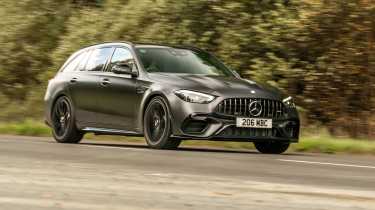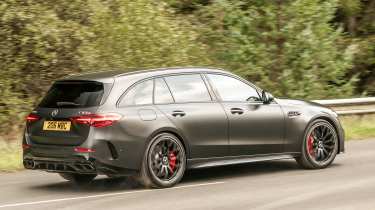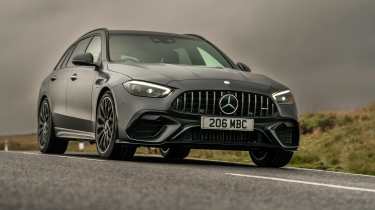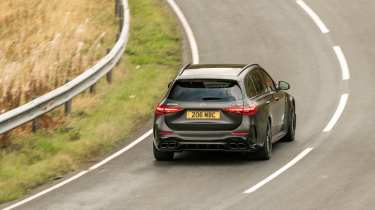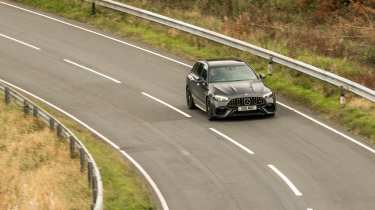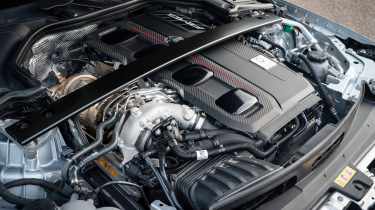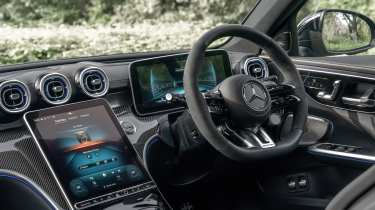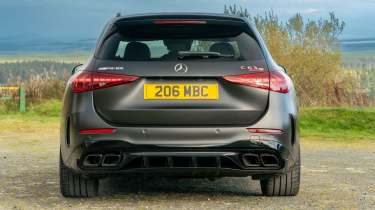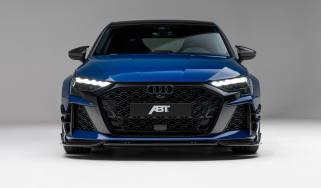Mercedes-AMG C63 S E Performance 2024 review – Affalterbach's BMW M3 rival misses the mark
Affalterbach’s new-generation C63 offers class-leading numbers, but it’s a complex car to get to know – in every sense
The 2023-on Mercedes-AMG C63 is perhaps the most radical AMG ever. Why? Because it throws out the tried-and-tested formula that we associate with the brand. No more 4-litre V8 powering the rear wheels. Now we have technology in abundance, marrying multiple power sources with an all-wheel-drive system. Its hybrid powertrain generates some very large headline figures, but alongside the impressive 670bhp there is also the worrying 2165kg kerb weight. The question is, which do you feel the effects of more?
We’ve now driven the Mercedes-AMG C63 both on its international launch in Spain in 2023 and subsequently on UK roads in 2024. Read on for our full review.
> Mercedes-AMG GLC 63 S E Performance 2023 review
Engine, gearbox and technical highlights
The engine is an uprated version of the M139 2-litre four-cylinder that has wowed us in the AMG A45 S. In the C63 S it is mounted longitudinally rather than transversely and it has a bigger turbocharger with its own electric motor to minimise lag. The result is 469bhp and 402lb ft (going through the familiar nine-speed multi-clutch ’box) making it the most powerful series-production four-cylinder available. However, that’s not all, because the C63 S also has a 6.1kWh battery and a permanently excited synchronous electric motor capable of producing 201bhp and 236lb ft of torque. This is deployed through a two-speed gearbox to the rear axle and is the same hybrid system used in the GT63 S and S63 E.
More reviews
The full 671bhp output is unlocked only in Race mode. The motor can give an extra boost – a bit like in early generations of the current hybrid WRC cars – by pushing the throttle all the way into its kickdown step.
The big story is the 400 volt battery which has been designed to allow both very fast charging and discharging. It has 560 individual cells and a ‘high-tech’ coolant that flows around them, keeping them at a consistent temperature that averages just 45 degrees Celsius. This thermal stability from the direct cooling has allowed AMG to fit the higher performance cells and it also helps the battery maintain its performance, with 94bhp (70kW) of continuous output and 201bhp (150kW) of peak performance in blasts of up to 10sec. Its modest capacity only allows for a maximum of eight miles of pure electric driving, but it also weighs a relatively svelte 89kg including 30 litres of coolant.
Performance and 0-60 time
With so much oomph, the 4MATIC all-wheel-drive system seems like a jolly good idea and in no small way helps the C63 S E Performance achieve its 0-62mph time of 3.4sec.
As a default, the C63 starts in electric mode and you may find yourself doing the ‘is it on?’ double-take between pressing the start button and pulling away. The C63 E Performance is quiet, if you’re in EV mode. Even when the internal combustion kicks in the noise is unusual because it sounds (from inside) much like a hot hatch. We’re fans of the mighty M139 four-cylinder, but it nonetheless provides a strange soundtrack for something in this segment. However, the powertrain provides smooth, easy progress in Comfort mode, turning the engine on and off without fanfare. That fast-charging battery is also impressive, with power available seemingly almost whenever it's needed.
Though very smooth and fast for the most part, the DCT gearbox was occasionally a little abrupt while driving in traffic during our first test of the C63 in the UK.
Ride and handling
There is still something of the manner of older AMG models in the way that the new C63 gets down the road: it feels responsive, serious, eager (and more communicative than lower-level AMG stablemates such as the E53). Sadly that extra weight over its forebears is all too palpable, however. On a good piece of road you initially sense it under braking, with a lot of momentum in action.
It turns with surprising agility thanks to the help from the rear-wheel steering, but over bumps and lumps there is a sense that you are driving a car much bigger than a C-class. It feels happiest in its Comfort mode on the suspension, but only if you back off the ultimate pace to maintain body control. If you ramp up the speed and the damping then it starts to thump rather than soak things up. That said, the ride is very good overall for a car of this mass, and it deals better with UK roads than we’d feared it might based on our experience during the Spanish launch.
The steering is not big on feel but superbly accurate and well insulated from kickback and so forth. Although you certainly feel the four-wheel-steering system in action, it’s not too intrusive; it’s less noticeable than in the AMG GT, for example. It clearly plays a part in how well the C63 changes direction.
Despite the headline figures, you can be surprisingly liberal with the throttle. The all-wheel-drive system keeps the torque largely contained; even when you throw everything at the exit of a tight corner the resultant slide is easily gathered up. Occasionally, there’s the odd sense of the car both slipping at the rear but also grabbing grip at the front as the all-wheel-drive system corrects itself.
If anything the outright response and performance doesn’t feel as impressive as the numbers would suggest. It feels quick, but not that quick. Blame the weight. Again.
You only get the full 150kW slug when you are in Race mode, have selected the Boost function and depressed the throttle all the way to the kickdown switch… And even then you shouldn’t necessarily deploy it at every opportunity on a track. There are boost strategies available for 70 circuits around the world and these will tell you (via graphics on the dash) when and where to apply full throttle in order to achieve the best lap time and retain as much battery for as long as possible. At Ascari, where the C63 S was launched, for example, the AMG boost strategy will see you go slightly slower over the opening half of the lap but then gain time during the second half.
It won’t surprise you to hear that this was all developed with input from both Mercedes-AMG's F1 and Formula E teams, for whom this sort of careful energy deployment has become second nature. It’s fascinating stuff… but fun? After a handful of these prescriptive laps, I’m not so sure. I think it would be really interesting understanding how to get the best from the car at different circuits, but there may be times when you just want to drive and not feel like you’re always holding back for fear of depleting the battery too quickly.
In terms of the handling on track, the weight was still apparent but the balance felt fundamentally decent. You needed to be careful not to overwhelm the front end, but a bit of judicious trail braking has the rear rotating nicely and with the 4MATIC all-wheel-drive system you can get back on the throttle early with no real worries about traction. The ESP Sport setting also deserves praise for being extremely discreet.
MPG and running costs
Combined fuel consumption according to WLTP test procedure is rated at 38.7mpg, for both saloon and estate. We’ve seen much lower figures than that during our test according to the on-board trip computer, in mixed driving scenarios. The C63’s WLTP CO2 rating is 167g/km.
Fuel economy of course varies according to the driving mode the car is in, and the C63 has plenty of them: Race, Sport Plus, Sport, Comfort, Electric, Battery Hold (to preserve the battery’s current level until reaching a city, for example, to make best use of it), Individual (where users can preset a combination of individual settings) and a Slippery mode, for winter conditions or very wet weather.
Then, if you press the steering wheel-mounted drive mode switch again, you can toggle three levels of regenerative braking, to recover energy and store it in the battery. Subjectively, the brake pedal feel is most natural on the least acute of the three regen settings; it feels more like a ‘dead pedal’ in the other two, with less feedback than other traditional brake pedals (despite a great deal of work by AMG’s engineers to mitigate against this). Although the C63 is a plug-in hybrid, it can charge its battery very quickly via the engine in Race mode (to enable it to deploy the motor for extra boost when called on).
Interior and tech
The interior is dominated by the huge central touchscreen and its MBUX infotainment system. There is an almost bewildering array of beautifully wrought graphics on the huge central touchscreen, the dash and even the head-up display. You can of course configure the dash and HUD to any one of multiple systems. Some evo testers prefer the Supersport design and its little orange flames which crackle across the screen every time you stoke its digital fire with the throttle pedal; others opt for the Classic design with its more easily readable trad rev counter and larger gear indicator.
The steering wheel’s dual cross spars each side are filled with switches, and there are two more driving mode satellite switches below. Although the wheel’s mix of leather and Alcantara is smart, its rim is chunky, and difficult to hold properly, which doesn’t help in terms of steering feel (literal and metaphorical).
The new bucket seats, with their faux holes for race harnesses and perforated leather, look fantastic and prove comfortable on long journeys, for our testers at least. There is certainly a lot going on in the interior; it could take weeks or even months of ownership to dial it all in to your liking and work out in which scenarios you want to use each of the eight different driving modes available. Even choosing your preferred colour of mood lighting, which seeps from vents and doors, could take hours.
Design
The C63 is a big car, and it feels it on the road. (Mind you, so do so many other cars currently.) It does look and feel suitably premium inside (though it should, given its near-six-figure price), and on the outside it certainly has presence. Even if it’s arguably a less memorable design than previous C63 generations, there’s still a likeable sense of purpose and attitude in the way the wheels are tucked into the arches in relatively racy angles of camber.
Despite being a big car on the outside, and a fairly large one inside too, there’s a curious sense of feeling a little hemmed-in when sat in the front. The transmission tunnel’s housing takes up a lot of lower room and the dashboard and steering wheel are so big that they too contribute to a slightly cramped feel.
It’s more roomy for rear passengers with plenty of headroom for an average-sized adult, though six-foot-plus occupants may find it tighter.
Verdict
There is so much going on with this new C63 S E Performance (even the name is complicated!) that it takes a good deal of time to really appreciate all of its facets fully. It’s a car that really takes some time to get to know, and our initial UK drive in the car has been brief. It’s undoubtedly a lovely thing to spend time in, with a fabulous interior and it is a remarkable technical achievement, with a huge spread of abilities that become more apparent with more miles and more scenarios to try the car in. However, there is no doubt that the 250kg that the hybrid system brings with it is palpable in the dynamics and ultimately impacts proceedings more than the mighty maximum power figure.
The four-cylinder engine’s sound isn’t particularly sonorous, which is a shame, but missing a rumbly V8 isn’t the reason for the lukewarm star rating based on our initial limited driving opportunities. It is the sheer weight, and the sheer level of complication that contributes to the new car being less fun than its predecessors. The older 63s were much more raw cars (and the new car’s long-distance refinement is in another league), but they were also more exciting and involving in the way they drove as well as for their hot-rod powertrains.
The weight and slight numbness, the feeling of there being so many layers between you and the car, ultimately are the undoing of this car more than its power source.
Perhaps if Mercedes had called it by another name, rather than C63, we’d feel more warmly towards it. As it is, it is a genuinely enjoyable and truly impressive car but not as captivating a car as its predecessors – based on these admittedly brief first testing opportunities, at least.
Price and rivals
The C63 S E Performance is available as either a saloon or an estate, and given the character of the car, it feels like it makes more sense as an estate. Given that the cheapest trim for the UK market is the Night Edition, prices start at an eye-watering £97,530 for the saloon, rising to £99,280 for the estate.
The traditional rivals for the saloon are the BMW M3 Competition xDrive (£85,715) and the Alfa Romeo Giulia Quadrifoglio (£79,495) – both are not only significantly cheaper but better to drive. We’ve criticised the M3 for being a bit heavy, but at 1780kg it looks like a paragon of Chapman philosophy compared to the AMG. However, neither the BMW nor Alfa has the ability to travel on purely electric power, which understandably might be important to some buyers.
The estate’s biggest rivals are the Audi RS4 Competition (currently sold out) and BMW's excellent M3 Touring (£86,570), both lighter than the hybrid C63, (albeit without being able to offer an EV mode).
Mercedes-AMG C63 S E Performance specs
| Engine | 1991cc turbocharged four-cylinder |
| Electric motor | Rear-mounted permanently excited synchronous motor |
| Gearbox | 9spd MCT, two-speed transmission on rear axle, eLSD |
| Power | 670bhp (469bhp @ 6725rpm + 201bhp) |
| Torque | 638lb ft (402lb ft @ 5250-5500 + 236lb ft) |
| Weight | 2111kg (317bhp/ton) |
| Electric range | 8 miles |
| 0-62mph | 3.4sec |
| Top speed | 155mph (173mph with AMG Driver's Package) |
| Price | £97,530 |
